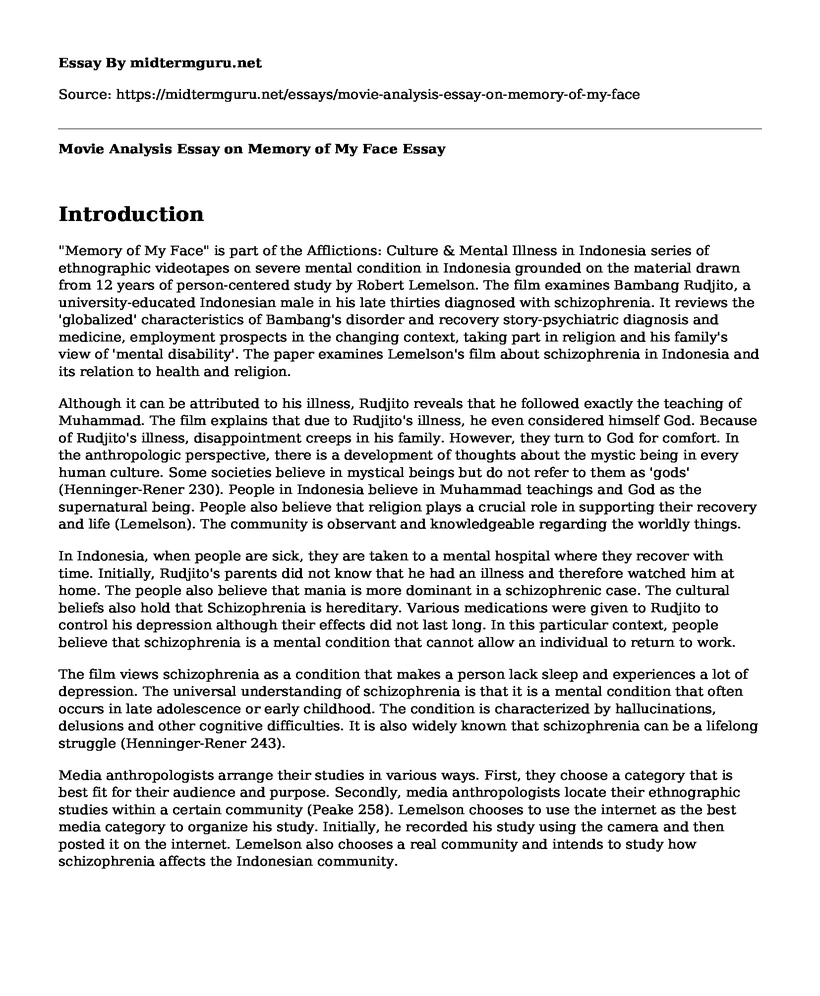Introduction
"Memory of My Face" is part of the Afflictions: Culture & Mental Illness in Indonesia series of ethnographic videotapes on severe mental condition in Indonesia grounded on the material drawn from 12 years of person-centered study by Robert Lemelson. The film examines Bambang Rudjito, a university-educated Indonesian male in his late thirties diagnosed with schizophrenia. It reviews the 'globalized' characteristics of Bambang's disorder and recovery story-psychiatric diagnosis and medicine, employment prospects in the changing context, taking part in religion and his family's view of 'mental disability'. The paper examines Lemelson's film about schizophrenia in Indonesia and its relation to health and religion.
Although it can be attributed to his illness, Rudjito reveals that he followed exactly the teaching of Muhammad. The film explains that due to Rudjito's illness, he even considered himself God. Because of Rudjito's illness, disappointment creeps in his family. However, they turn to God for comfort. In the anthropologic perspective, there is a development of thoughts about the mystic being in every human culture. Some societies believe in mystical beings but do not refer to them as 'gods' (Henninger-Rener 230). People in Indonesia believe in Muhammad teachings and God as the supernatural being. People also believe that religion plays a crucial role in supporting their recovery and life (Lemelson). The community is observant and knowledgeable regarding the worldly things.
In Indonesia, when people are sick, they are taken to a mental hospital where they recover with time. Initially, Rudjito's parents did not know that he had an illness and therefore watched him at home. The people also believe that mania is more dominant in a schizophrenic case. The cultural beliefs also hold that Schizophrenia is hereditary. Various medications were given to Rudjito to control his depression although their effects did not last long. In this particular context, people believe that schizophrenia is a mental condition that cannot allow an individual to return to work.
The film views schizophrenia as a condition that makes a person lack sleep and experiences a lot of depression. The universal understanding of schizophrenia is that it is a mental condition that often occurs in late adolescence or early childhood. The condition is characterized by hallucinations, delusions and other cognitive difficulties. It is also widely known that schizophrenia can be a lifelong struggle (Henninger-Rener 243).
Media anthropologists arrange their studies in various ways. First, they choose a category that is best fit for their audience and purpose. Secondly, media anthropologists locate their ethnographic studies within a certain community (Peake 258). Lemelson chooses to use the internet as the best media category to organize his study. Initially, he recorded his study using the camera and then posted it on the internet. Lemelson also chooses a real community and intends to study how schizophrenia affects the Indonesian community.
Conclusion
Conclusively, schizophrenia most commonly occurs between the ages of 16 and 30. In numerous cases, the condition develops so slowly that the person does not know how they have acquired it. In the film by Lemelson, the individual develop schizophrenia in his teenage years and the family members did not realize it at first. Religion plays a huge role in the health of people in Indonesian culture. People believe that rituals to the supernatural being are the reason that people live a peaceful life. In addition, the views of the Indonesian people are similar to the common views across the world.
Works Cited
Henninger-Rener, Sashur. Chapter 10 - Religion. (n.d). https://courses.lumenlearning.com/suny-esc-culturalanthropology/chapter/religion/ Accessed 24 July 2019.
Henninger-Rener, Sashur. Chapter 11 - Health and Medicine. (n.d). https://courses.lumenlearning.com/suny-esc-culturalanthropology/chapter/health_and_medicine/. Accessed 24 July 2019.
Lemelson, Robert. Afflictions Series - Memory of My Face [Video file]. Documentary Educational Resources, uploaded by Davidov, July 18, 2019, https://www.youtube.com/watch?v=s1IDoAxOjBo.
Peake, Bryce. Chapter 12 - Media Anthropology. (n.d). https://courses.lumenlearning.com/suny-esc-culturalanthropology/chapter/media/. Accessed 24 July 2019.
Cite this page
Movie Analysis Essay on Memory of My Face. (2023, Jan 29). Retrieved from https://midtermguru.com/essays/movie-analysis-essay-on-memory-of-my-face
If you are the original author of this essay and no longer wish to have it published on the midtermguru.com website, please click below to request its removal:
- Ideas for Feature Drama Film - Paper Example
- Movie Review Paper Sample: We Need to Talk About Kevin
- Breaking the Taboo Essay Example
- Mental Illness and the Freedom to Refuse Treatment: Privilege or Right? - Article Analysis Essay
- How Technology Affect Human Interaction? - Paper Example
- Epidemiology of PTSD: Prevalence Across Countries - Research Paper
- Racial and Ethnic Stereotypes in Mass Media: The Unseen Impact - Essay Sample







